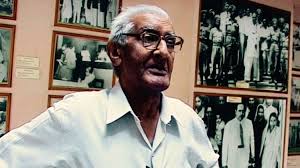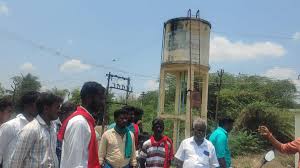Bhagwan Das: The Intellectual Prodigy Who Amazed Dr. BR Ambedkar with His Knowledge

In this story of Dalit History Month, we trace the journey of Bhagwan Das, a towering personality from the Dalit community, who played an instrumental role in introducing Ambedkar to the world by publishing his writings and speeches even before the Maharashtra government did so. He also raised the issues of Dalit atrocity on international platforms.
Pratikshit Singh
Bhagwan Das was born in Shimla on 23rd April 1927, into an untouchable but relatively well-to-do family in the Jutogh Cantonment area. As a teenager in 1943, he waited for 7 hours outside a CPWD bungalow near Cecil House in Shimla to meet Dr. Babasaheb Ambedkar, who was staying there. His father, Ram Ditta, was an avid reader of newspapers and a great admirer of Ambedkar. Unfortunately, his father passed away a few months before he met Ambedkar.
“Ambedkar was quite popular amongst our people,” said Das in his memoir “In Pursuit of Ambedkar,” published by Navyana Publication. This meeting marked the beginning of his association with Ambedkar, leading to several more meetings and eventually working under him as his research assistant. Regarding their first meeting, Das mentioned in a book, “I was not prepared to ask for anything in specific. However, I said I wanted to serve in his ministry. He again asked me my name, and then I left, thanking him. Within about three weeks, I got a letter of appointment issued from Delhi.”
This initial encounter led to a long-term association with Ambedkar, as Bhagwan Das became his research assistant and worked under him at his residence on Alipur Road, Delhi. However, Ambedkar passed away in 1956, when Bhagwan Das was just 29 years old. Das has mentioned an interesting event in his books and interviews: one evening, around 5 o’clock, he was sitting with Babasaheb in the verandah, with Charles Darwin’s book ‘The Origin of Species’ in his hands. Taking that book from Bhagwan Das, Babasaheb said, “I do not agree with Darwin who gave and propagated the theory of ‘Survival of the fittest’”.
The young research scholar humbly asked for permission to say something and then said, “Darwin did not formulate the theory of survival of the fittest. He only wrote that species which fail to make adjustments with the changing environment become extinct”. Astounded by Das’ knowledge, Ambedkar asked if he had an MA in Anthropology, to which Das replied that he was a school dropout.
This incident took place just months before Ambedkar’s death in 1956. After his death, Das ensured that Ambedkar’s work was published, and in 1963, he published “Thus Spoke Ambedkar.” It is a collection of speeches delivered by Dr. BR Ambedkar at the Round Table Conference in London and also his views regarding labor, democracy, and the constitution of India. This was the first volume published on Dr. Ambedkar’s speeches in 1963, with four subsequent volumes published later. He played an instrumental role in getting Dr. Ambedkar’s works published between 1963 and 1980.
In the 1970s, Das managed to complete his education and went on to obtain an MA in History from Punjab University and an LL.B from Delhi University. He used his law degree to litigate at the Supreme Court, where he founded the Ambedkar Mission Lawyers Association and Legal Aid Society in 1989, aiming to help advocates from untouchable groups develop professional competence.
In pre-independent India, when English as a language was confined to the English themselves and the foreign-returned elites of India, Bhagwan Das, a school dropout, could speak fluent English. Das attributed his fluency in English to his English neighbors, Reverend A.A. Andrews and his wife, who made sure that he spoke correct English. Das served with the Royal Air Force as a Radar Operator under the South East Asia Command. After demobilization, he served under various government departments from his hometown Shimla to Saharanpur and Delhi.
Besides English, he also acquired knowledge of Urdu and translated Lyndon Johnson’s book ‘My. Hope for America into Urdu. Retired IPS officer S.R. Darapuri, who also happens to be his relative as his son is married to his daughter, said Mr. Das had toured almost the whole of India to study the problems of Hindu-Muslim riots, religious conflicts, atrocities committed on the Untouchables and tribal people, with the group ‘Threat to Diversity’, ‘Swaraj Mukti Morcha and as Chairman, Samata Sainik Dal. He was also the founder President of Dalit Solidarity People, an organization aiming at uniting Hindu Dalits, Dalit Christians, Sikh Dalits, Muslim Dalits, and Burakumons of Japan and Korea. He had been a storehouse of insight and information; his residence in Delhi had been a mandatory stopover for many renowned scholars like Eleanor Zelliot, Mark Juergensmeyer, Owen Lynch, Marc Gallanter, RK Kshirsagar, Sukhadeo Thorat, etc.
The grasp over the English Language came in handy later in his life also. Das used his knowledge of English to internationalize the issue of caste with involvement in the United Nations.
He spoke to Vidya Bhushan Rawat, a filmmaker, and social activist, who said Mr. Das was invited to deliver a lecture on ‘Discrimination’ by the Peace University, Tokyo (1980) and also addressed several meetings organized by the Burakumins of Japan. He presented the case of untouchability before the UNHRC (United Nations Human Rights Commission) in Geneva in 1983. When I came to Delhi in the 1990s, he was my guru, and he initiated me into Ambedkarism. Das also met world leaders like Jimmy Carter, the then US president in 1980. He added that he was one of the founder members of the World Conference on Religion and Peace (WCRP) (India) and participated in the Conferences held in Kyoto, Japan (1970); Princeton, USA (1979); Seoul, Korea (1986); Nairobi, Kenya (1984), and Melbourne, Australia (1989). He was appointed Director of the Asian Centre for Human Rights of the Asian Conference on Religion and Peace in 1980 and served in that capacity to monitor cases of violation of human rights.
Bhagwan Das noted in his book “Main Bhangi Hoon” that it was after mass conversion of people from the Lal Begi (Bhangi) community to Christianity in the districts of Gurdaspur and Sialkot that the Arya Samajis fabricated the story that the putative author of Ramayana- Valmiki belonged to the Chuhra community.
Bhagwan Das noted in his book “Main Bhangi Hoon” that it was after mass conversion of people from the Lal Begi (Bhangi) community to Christianity in the districts of Gurdaspur and Sialkot that the Arya Samajis fabricated the story that the putative author of Ramayana- Valmiki belonged to the Chuhra community.
In his testimony before the UNHRC in Geneva on 19th August 1983, Bhagwan Das fully exposed the hypocrisy of the Indian Government, as it had pushed the issue of caste under the carpet by declaring it a social problem. Bhagwan Das had requested the appointment of UNO rapporteurs to monitor atrocities on Dalits and implementation of various laws, which led to the appointment of two rapporteurs for India in 2005, and caste discrimination was included as a form of Racial Discrimination in UN documents in 2001.
In 2001, he went to attend the World Conference Against Racial Discrimination in Durban. He visited the UK in 1983, 1988, 1990, and 1991 for lectures and seminars. He participated in the seminar held at Hull University in 1990 as a representative of the Ambedkar Centenary Celebration Committee UK.
“Main Bhangi Hoon” remains the most read book by Das. Although widely misunderstood to be his autobiography, it is the story of an Indian sweeper told in the first person. The book also traces the origin of the sweeper community in India.
Bhagwan Das noted in his book “Main Bhangi Hoon” that it was after mass conversion of people from the Lal Begi (Bhangi) community to Christianity in the districts of Gurdaspur and Sialkot that the Arya Samajis fabricated the story that the putative author of Ramayana- Valmiki belonged to the Chuhra community. “Hindus started preaching about Hindu religion among the untouchables in the last decades of the nineteenth century in order to fool the untouchables for the fear that the population of Hindus would be less than that of the Muslims in the Census. Coming under the influence of this propaganda, the people of the Chuhra caste of Punjab started writing the name of their caste as Valmiki. The sad thing is that not only did it stop their mental, political, economic, and social progress, but it also caused a greater loss that the writers of this caste, instead of thinking and writing about their other problems like poverty, backwardness, superstition, social evils, injustice, and atrocities on them, went after Valmiki, who probably has no direct connection with the Bhangi caste,” writes Das in “Main Bhangi Hoon,” asserting that the Valmikis were originally Lal Begis.
Other books written by him include “Valmiki aur Bhangi Jatian” (Hindi); “Valmiki” (Hindi); “Dhobi” (Hindi); “Revival of Buddhism in India and Role of Dr. B.R. Ambedkar”; “Dr. Ambedkar Ek Parichay Ek Sandesh”; “Dr. Ambedkar aur Bhangi Jatiya,” and “Bharat me Bauddh Dhamm ka punrjagran tatha samasyayen.”
Bhagwan Das died on 18th November 2010 in Delhi. He is survived by his daughter Shura Darapuri, a History Professor at Baba Saheb Bhim Rao Ambedkar University, and son Rahul Das, who lives in Delhi.
Today, when the Hindutva-Supremacist government is at the center and is working on the agenda to Hinduize the Dalit communities at a war footing, Bhagwan Das and his work become more relevant.
Bhagwan Das: The Intellectual Prodigy Who Amazed Dr. BR Ambedkar with His Knowledge
Courtesy : The Mooknayak
Note: This news is originally published in outlookindia.com and was used solely for non-profit/non-commercial purposes exclusively for Human Rights.






